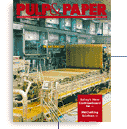|

KELLY H. FERGUSON
is Editor.Pulp & Paper
|

In and out of "The Box"
The box. From the outside looking in, it has long been a symbol of our industry. On the positive side, it is basic, simple, and useful. On the negative side, it is fairly plain and not very adaptable.
For years the industry has flown high the “Paper” banner of “renewable resource,” “eco-friendly product,” and “a staple of life.” All of those labels are true, and have been hammered home to consumers and the business community. But do they matter? Are they the messages that can carry the industry forward, or do they hold individual companies back from being more than just “a paper company?”
THE NATURE OF COMPETITION. In this issue, P&P kicks off a look at the industry’s future with an ongoing series of articles, columns, and commentary called “Vision 2000.” The first article, written by Dr. Jim McNutt, looks at the paper industry and how it has been shaped organizationally and technologically by business leaders from the past, both inside and outside the industry. He then goes on to challenge “higher-ups” in paper companies to adjust their thinking and to help those throughout the organization adjust as well.
One of the more intriguing points of McNutt’s article is a discussion of competition and who the true competitors are for the individual and institutional consumers that use paper. The industry has long waged war with the “archenemy”—plastics. Once upon a time, we campaigned hard for the grocery sack market, and yet most of the stores that I enter rarely even ask, “Paper or plastic?”
Consumers have moved on and don’t have time to dwell on such things as the transportation medium for their groceries. But plastic isn’t really the enemy. It is just another competing medium that satisfies some physical or economic need of either the consumer or the go-between (in this case, the grocery store owner.)
Other sectors that have traditionally used paper are changing in the same way. Take communications companies, for example. Once dominated by paper, the communications and information business has been constantly segmented by such media as radio, television, and now e-mail and the Internet.
For those of us in the information business, it is short-sighted to think of ourselves as operating in only one medium. Our customers—you—want and can receive information in many ways. If we understand your needs and wants, we will be able to use all media—paper, email, Internet, broadcast, etc. But in doing so, we change the nature of our company.
STRUGGLING WITH THE SHIFT. Recently, I was asked by a team of people from an older mill to share some perspectives on the industry and to participate in a discussion as they examine the type of mill and company they want and need to be in the future. It was refreshing to see this group tackle technological limitations and organizational restraints to find ways to secure and grow their mill’s business. And it wasn’t just a group of managers but included production, human resources, marketing, administration, and technical.
Instead of being satisfied with an existing customer base and producing tons to justify their assets, this team is exploring markets where their product has real value, and they are working to understand how existing customer needs will change as society places different demands on those customer products. As the discussion proceeded, it was amazing to see how the technical and production team members easily transferred their expertise into how such products might be manufactured or what would be needed to make those products happen.
It’s likely that this isn’t the only such effort going on in an industry where profitability has suffered and where the race to produce more tons of commodity products is being won by offshore mills with the latest in big, fast machinery. In an industry where tonnage has traditionally been king, the question is whether companies can overcome the importance of tons out the door and focus more on producing a unit of product that is relevant to customer needs.
The “Vision 2000” series that begins in this issue will explore many of these topics from both inside (mills, companies, individuals) and outside (converters, customers, market segments) the box. Let’s just hope “The Box” is adaptable.

|




